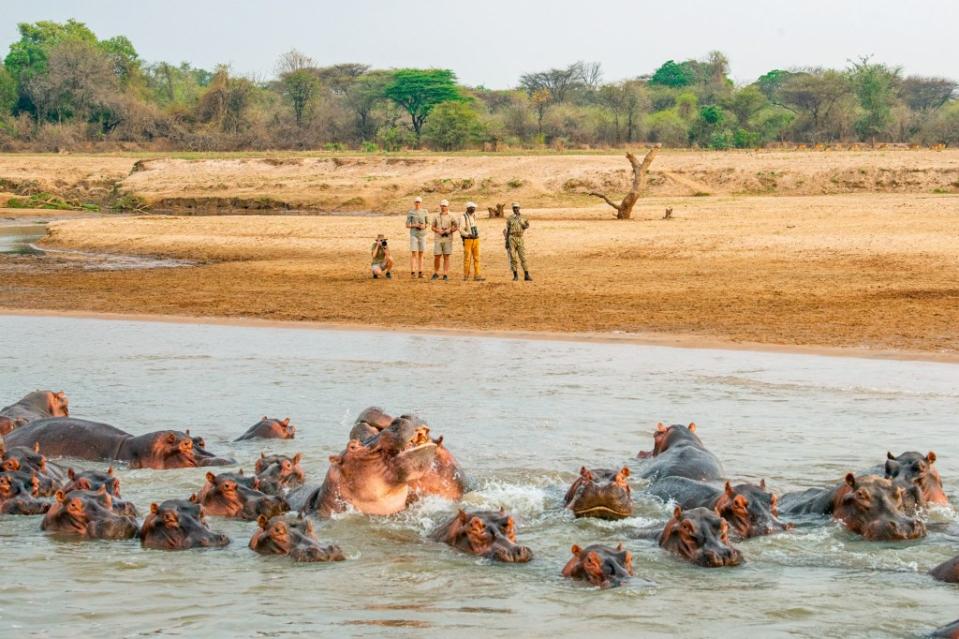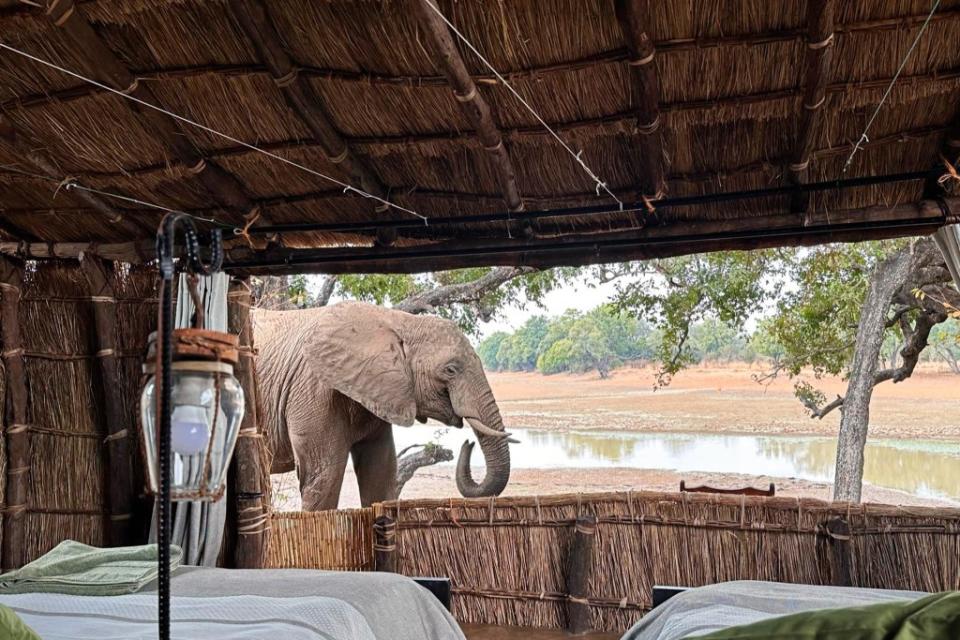How to safari without the Jeep
Our group of six chatted quietly as we strode across the dusty, sun-scorched terrain of Zambia’s South Luangwa National Park early on a September morning, the dry season’s unrelenting rays warm on our faces. Suddenly our guide, Alex Phiri, stopped and raised his hand, bringing his finger to his lips.
I followed his gaze. Some 100 yards straight ahead stood a 3,500-pound hippopotamus, staring squarely in our direction.
Phiri quickly ushered us behind a tree, where we cowered, our hearts beating fast—the only sound birdsong. The world’s third-largest land mammal, the hippo is ferocious when it feels threatened, and can be more dangerous than notoriously fearsome animals such as lions.
This hippo swung its huge head to the right, then slowly back toward us—then repeated the motion several times, as if engrossed in an intense tennis rally. The park ranger accompanying us (standard procedure on any walking safari) slowly lifted his rifle, training it on the animal in case it decided to charge.
After one more lingering look our way, the hippo turned and lumbered off, away, and eventually out of sight. “Well, that was lucky,” Phiri said, smiling wryly as we collectively exhaled. “He was either heading that way, or straight at us.”

It’s not an experience I would have had on a more traditional Jeep safari, in which the metal barrier of the vehicle and the ability to make a quick escape provide some separation from wild beasts. But such spine-tingling encounters are always a distinct possibility when traversing the bush on foot.
It was here in South Luangwa—one of the world’s great wildlife sanctuaries—that the British conservationist Norman Carr first led walking safaris for tourists in the 1950s. A largely under-the-radar experience for many years, they’re becoming more popular as intrepid safari-goers seeking a culturally connected and environmentally sensitive experience opt to leave the Jeep behind. Dedicated walking safaris are still a niche sector offered by only a handful of operators, and like all high-quality safaris, they can be pricey, starting at around $1,000 a day per person during high season.
“We’ve certainly seen an uptick since COVID—I think it’s part of a general movement toward a greater immersion in nature after a couple years of lockdown,” says John Coppinger, a former guide and owner of Remote Africa Safaris, which runs five camps—three of them walking-only—across South Luangwa and North Luangwa National Parks. “There’s no sound of the engine, no smell of diesel—you really become part of it all,” Coppinger continues. “You’re not only up close and personal with the big game, but you see so many of the little things that you never pick up in a vehicle.”
Indeed, ambling single file (a safety precaution) along trails forged by elephants and hippos over countless generations offers a sensorial smorgasbord and a way to explore these ancient landscapes in step with the local people who know them best.
Ambling along trails forged by elephants and hippos over countless generations offers a sensorial smorgasbord.
During a walking safari through Kenya’s 58,000-acre Loisaba Conservancy—its shimmering green-gold hills studded with kopjes (red-rock outcroppings)—our guide, Bashir Ali, showed us wild basil, used locally as an insect repellent, and the “toothbrush tree” (euclea divinorum, in Latin) a handy helper in the bush. This botanical lesson was on a recent visit to Loisaba Lodo Springs, the newest addition to the Elewana Collection, which operates 15 camps and lodges across Kenya and Tanzania. Ali was gleeful when I spotted a leopard tortoise—a member of the “Little Five” (which also includes the ant lion, elephant shrew, red-billed buffalo weaver, and rhino beetle). Africa’s smaller species, it turns out, can be as thrilling as the iconic “Big Five” (leopard, lion, elephant, rhino, and buffalo).
If getting out of the Jeep seems daunting, it’s worth remembering that humans have walked these paths for millennia. “In Kenya, Maasai and Samburu tribesmen have grown up looking after their fathers’ cows with little more than a rungu—a throwing club—a walking stick, and a sword,” explains Sacha Toronyi, Elewana’s guide trainer, who has led walking safaris for 30 years. “They learn to coexist with nature from a very young age, so by the time they become guides, they’re ahead of everyone in understanding local ecosystems and animal behavior.”
Another close call back in Zambia illustrated his point. The morning after avoiding the hippo charge, our group embarked on a four-hour sojourn to Remote Africa’s Big Lagoon Camp, surrounded by ebony forest on the Luangwa River’s west bank.

I was lost in reverie after watching three giraffes, still as statues, nibbling acacia branches in the soft morning light—when a gesture from Phiri stopped us short. Less than 10 seconds later, a sounder of warthogs—a mother and her babies—shot out from their underground den on the path ahead of us. One after another like cannonballs, they raced off, tails held high.
We looked at each other, dumbstruck. “How did you know they were coming?” I asked Phiri, who had grown up in the local Mkasanga village. “I felt the vibrations as they moved underground,” he replied casually.
Walking safaris are designed to avoid risky run-ins, but they are plenty thrilling, and can offer animal encounters otherwise unheard-of. Though a solitary buffalo is another of Africa’s most dangerous animals, a large herd of them—which can number up to a thousand in South Luangwa—is another story.
“They’re just like cattle—you can literally walk through them, and they make space for you,” explains Jennifer Coppinger-Riddin, John’s daughter and Remote Africa’s general manager. “You’re not just seeing them … but you’re smelling them, and as they move they kick up dust all around you. It’s quite immersive, and you’re right in the thick of it.”
If you're very lucky, trekking through the bush can even bring you up close to one of the continent's most endangered species. Remote Africa's walking-only Mwaleshi Camp is shrouded by the remote wilderness of North Luangwa National Park, home to Zambia's only population of wild black rhino. And in January, 21 black rhinos were relocated to the Loisaba Conservancy––where Elewana is the only accommodations provider––elevating the sprawling sanctuary to "Big Five destination" status. The monumental move marks one of Kenya’s most significant translocations to date, and the first time Loisaba has seen rhinos since poachers killed off the last of the species there 50 years ago.
For walking-safari devotees, part of the attraction is space and solitude—cherished rarities conspicuously absent at famous safari destinations like the Maasai Mara, where a wildebeest river crossing during the Great Migration will attract hundreds of Jeeps jockeying for a glimpse of the action.
“Walking along pathways created by these magnificent animals over many thousands of years … you feel truly connected to the earth,” says Elewana’s Toronyi. “It’s a whole other world out there.”
A version of this article appears in the April/May 2024 issue of Fortune with the headline, “The no-Jeep safari.”
This story was originally featured on Fortune.com

 Yahoo Finance
Yahoo Finance 